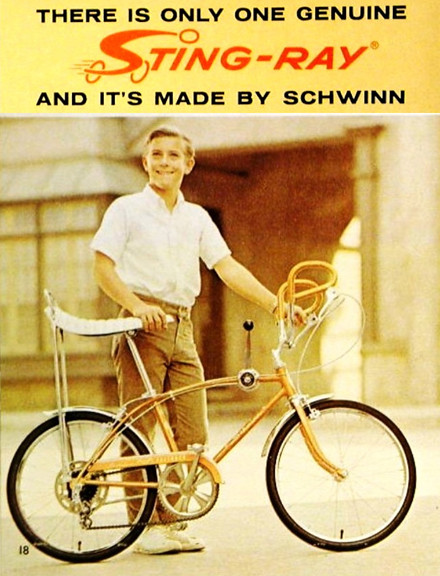When the Schwinn Bicycle Co. began producing the Sting-Ray
50 years ago this June 1, top executives never imagined that the sporty
two-wheeler with butterfly handlebars and a banana seat would become a national
sensation. Even the company's president playfully bet against its success.
"Before the first model rolled off the line, Frank V. Schwinn saw my
father pull a prototype out of his trunk and bet him $100 it wouldn't exceed
25,000 units in the first year," said Mike Fritz, whose father Al Fritz
designed the Sting-Ray (and died May 7). "Mr. Schwinn had to pay up within
weeks."
As demand for the bike surged—an estimated 700,000 were sold
by 1968—a new demographic emerged: teens who prized standing out rather than
blending in. From the start, the Sting-Ray was geared to budding show-offs.
From 1963 to 1981, Schwinn marketed the Sting-Ray like a
sports car to teens too young to drive. The company even created a line of
aftermarket accessories. In the late '60s, Sting-Ray owners could attach a
tall, chrome "sissy bar" in back or replace their rear balloon tire
with a treadless "slick"—enabling them to leave a patch of rubber on
pavement and fishtail to a stop.
"One of the bike's most attractive features had little
to do with its looks," said David Herlihy, author of "Bicycle: The
History." "On the bike, you could pop a wheelie by pulling hard on
the high handlebars and riding only on the rear tire. The bike gave teens this
outlaw image and helped them get comfortable with fear."
Like many teen trends of the early '60s, the Sting-Ray had
its roots in Southern California. In the summer of 1962, as freestyle dance
crazes like the Twist caught on and the Beach Boys harmonized about hot rods,
enterprising teens in suburban Los Angeles were spotted riding bikes they had
assembled from spare parts.
Huffy Corp.—the nation's No. 3 bike company at the
time—noticed the trend and began producing a black high-rise bike in March 1963
called the Penguin. But Huffy lacked Schwinn's powerful distribution and retail
network. "Al [Fritz] and I went to the West Coast around the same time as
Huffy to see what was going on," said Sting-Ray engineer and Olympic
cyclist Frank Brilando. "The kids showed us their bikes. They had taken
20-inch frames and put on chopper motorcycle handlebars and long seats that
could hold two riders."
When Fritz and Brilando returned to Schwinn's headquarters
in Chicago, they set to work on a design. "Executives were worried the
bike's low pedals might be dangerous on turns, so we adjusted the design,"
said Brilando. "As for the wheelies, we just didn't promote them."
Once the Sting-Ray was launched in June '63, the new bikes
turned heads. "I had one of the first models—it was a dark metallic
purple," said Richard Schwinn, a nephew of Frank V. Schwinn and now CEO of
Waterford Precision Cycles. "It was a big hit, but I was always afraid
kids wanted to be friends with me just to ride it."
Among the first Sting-Ray orders came from George Garner,
who owned three bike stores in the Los Angeles area and was the largest-volume
Schwinn dealer in the country. "I had modeled my stores on car showrooms,
and when kids came in with their parents, they wouldn't look at anything else
except a Sting-Ray," said Garner. "The bikes practically sold
themselves."
In 1968, with color-TVs and muscle cars on the rise, Schwinn
rolled out its Sting-Ray Krate line. Krates came in vibrant colors like apple
red and lemon yellow and the option for a three-speed stick shift mounted on
the frame. The Krates also featured a smaller front wheel, giving the bike a
dragster profile.
By the early '70s, aging teens were graduating to 10-speeds
and discarding their sporty old Schwinns. "A new generation of California
teens hauled those old Sting-Rays out of junkyards and customized them with
shock absorbers and heavier wheels to handle dirt tracks," said Frank
Berto, author of "The Birth of Dirt: Origins of Mountain Biking."
The Schwinn brand is owned today by Quebec-based Dorel
Industries DII.B.T -0.98% and represents a sizable slice of its bike business
in North America—but there are no plans to revive the Sting-Ray.
"It was a cool-looking bike that could do new
things." said Eric von Hippel, professor of technological innovation at
the MIT Sloan School of Management. "But it also became an innovation
platform for the next generation of teens, who moved the industry to the next
big thing—all-terrain biking."





No comments:
Post a Comment